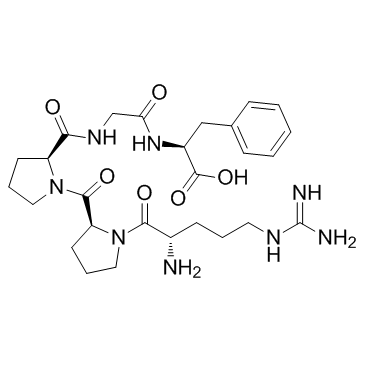Bradykinin metabolism in rat hind limbs.
J A Griswold, C R Baker, D T Little, G H Little, F J Behal
Index: Shock 10(2) , 146-52, (1998)
Full Text: HTML
Abstract
The purpose of this study was to assess the capacity of perfused rat hind limbs, the majority of which is skeletal muscle, to inactivate bradykinin (BK), and to compare the BK degrading capacity of rat hind limbs with the BK degrading capacities of rat lung and liver. BK, with tritiated Pro2 and Pro3 residues, in an asanguinous salt solution was perfused for a single passage through skeletal muscle and other tissues in the hind legs of the rat over a concentration range of .0029 to 49.3 microM. Rat hind limbs had a large capacity to degrade BK and the system did not approach saturation, even at 49.3 microM. A least-squares linear regression analysis and extrapolation to zero concentration was used to obtain values for amounts of BK degraded and BK fragments formed. The amount of BK cleaved was 95% of the administered dose. The major BK fragments formed, and the amount of each expressed as a percentage of the amount of BK degraded were Pro-Pro (BK 2-3), 8.6%; Arg-Pro-Pro-Gly-Phe (BK 1-5), 82%; and Arg-Pro-Pro-Gly-Phe-Ser-Pro (BK 1-7), 6%. The BK 1-5 yield was reduced from 82% to one-fourth of that by angiotensin converting enzyme (ACE) inhibitors. BK 2-3 formation is indicative of initial aminopeptidase-P cleavage of BK to yield Arg, and des-Arg1-BK. ACE inhibitor sensitive formation of BK 1-5 is indicative of initial kininase-II, also known as ACE, cleavage of BK. Thus in rat hind limbs, the ACE pathway is the preponderant mechanism for BK degradation, which is in contrast to our previously published reports that in rat liver the amino-peptidase-P pathway predominates, and that in rat lung both the aminopeptidase-P pathway and the ACE pathway exhibit nearly equal capacities to degrade BK.
Related Compounds
| Structure | Name/CAS No. | Molecular Formula | Articles |
|---|---|---|---|
 |
Bradykinin Fragment 1-5
CAS:23815-89-6 |
C27H40N8O6 |
|
Angiotensin-converting enzyme inhibition and smoking potenti...
2004-10-01 [Clin. Pharmacol. Ther. 76(4) , 379-87, (2004)] |
|
Thrombostatin inhibits cyclic flow variations in stenosed ca...
2001-11-01 [Thromb. Haemost. 86(5) , 1296-304, (2001)] |
|
Thrombostatin FM compounds: direct thrombin inhibitors - mec...
2008-05-01 [J. Thromb. Haemost. 6(5) , 837-45, (2008)] |
|
Oral thrombostatin FM19 inhibits prostate cancer.
2010-11-01 [Thromb. Haemost. 104(5) , 1044-8, (2010)] |
|
Mapping the interaction of bradykinin 1-5 with the exodomain...
2005-01-03 [FEBS Lett. 579(1) , 25-9, (2005)] |